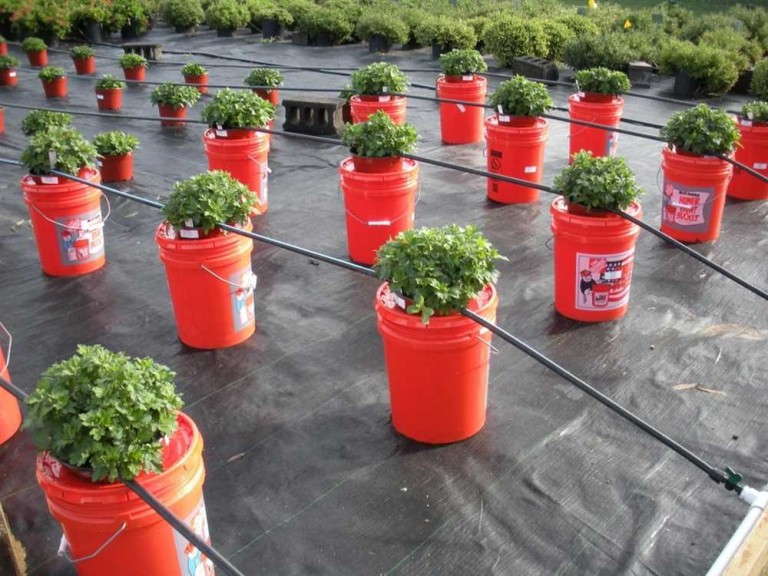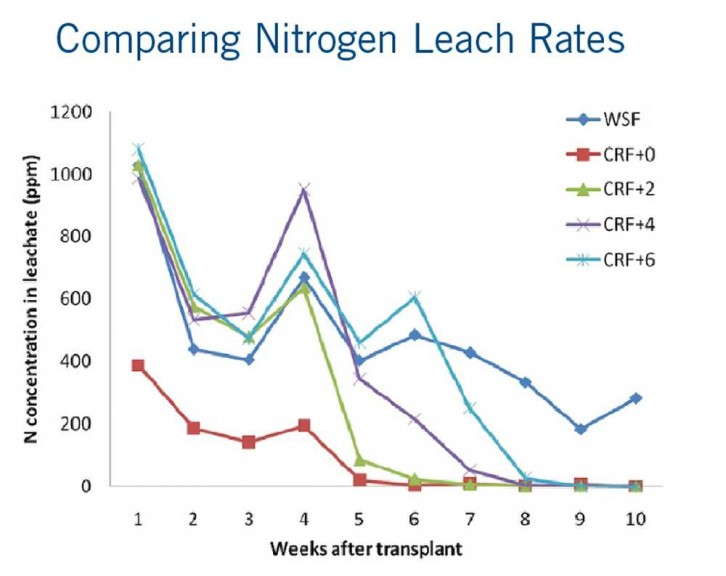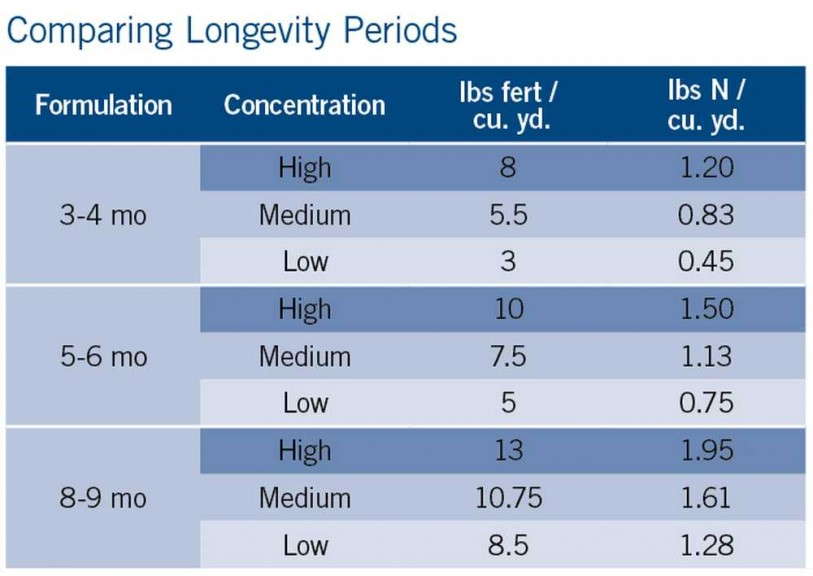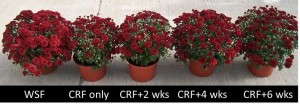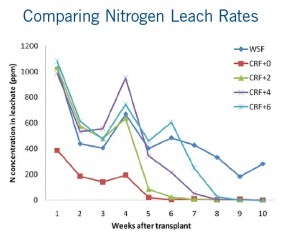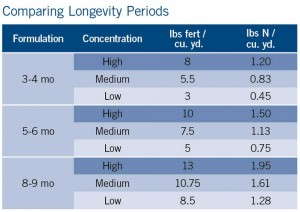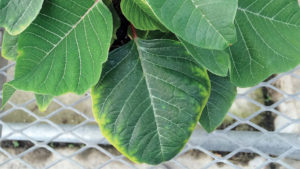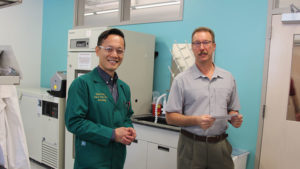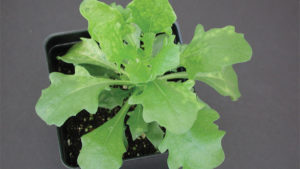Using Controlled Release Fertilizers To Produce Garden Mums
Garden chrysanthemums are a staple fall crop. Rated as moderately heavy users of fertilizer, potted garden mums produced by commercial growers are most often fed through drip tape with water-soluble fertilizer (WSF). As garden mums are often grown outdoors, there is an increased potential for liquid fertilizer to be leached out by excess irrigation and summer rains.
We wanted to determine if quality garden mums could be grown with controlled-release fertilizers (CRF) and whether or not this would significantly reduce fertilizer leaching, as compared with WSF.
[blackoutgallery id=”61765″]
Which Longevity Should Be Used?
CRFs are available in formulations with a variety of release periods or longevities. That is, CRF prills have coatings that affect how quickly their nutrients are released. Common release periods are three, six, nine and 12 months. The rate of nutrient release depends on temperature, and products are often rated for release at 70°F. When average daily temperatures are warmer than the rated temperature, the nutrients will be released more quickly than the label release period.
We grew chrysanthemum ‘Grandeur White’ using nine different CRF formulations with Osmocote Plus 15-9-12 and no liquid fertilizer. We used three longevity periods of the Osmocote Plus: three- to four-month, five- to six-month and eight- to nine-month; and each material was incorporated at low, medium and high rates (Slideshow Table 1). Plants were compared to a WSF control (250 ppm N from 20-10-20). Rooted cuttings were transplanted into 9-inch mum pans with Sun Gro Sunshine Mix #8 in late June. The plants were grown outdoors on drip tape at Cornell University’s Long Island Horticultural Research and Extension Center (Riverhead, N.Y.). CRF plants received only tap water while WSF control plants received constant liquid feed through the drip tape. Plants were evaluated when buds were beginning to show color in September.
This research showed that it is possible to grow a potted garden mum with only CRF rather than the traditional WSF procedure (Slideshow Photo 1). Plants grown with CRF were greener than the slow-release treatments, but the size of plants were equal in some of the Osmocote Plus treatments. Mum plants that were grown at the highest rates of the three- to four-month, five- to six-month and eight- to nine-month formulations were equal in size to the WSF plants. Even the medium rate of the eight- to nine-month formulation was equal in size to the WSF plants. All plants in the medium rate of each of the three formulations were marketable plants, although in some cases smaller than the WSF plants. If plants are grown with CRF and are less green in color than is desirable, they can be fertilized with WSF for the 10 days before sale.
Combining CRF With WSF
Next, we wanted to determine how garden mums performed when using different combinations of CRF and WSF. In addition, we wanted to quantify nutrient leaching based on fertilizer strategy.
Rooted cuttings of chrysanthemum ‘Helen’ were transplanted into nine-inch mum pans with Sun Gro Sunshine Mix #8 in late June (week 25). Plants received one of five fertilizer treatments: WSF only (applied as constant liquid feed at about 250 ppm N from 20-10-20 N); CRF only, with 11 lbs/yd3 of Osmocote Plus eight- to nine-month; or CRF at 8.5 lbs./yd3 plus WSF for the first two, four or six weeks following transplanting. Plants were grown outdoors with drip tape as noted above. To capture nutrient leachate, each pot was placed into a lid above a five-gallon bucket (Slideshow Photo 2). Every week, the volume of leachate was noted, and a sample was taken and sent to a laboratory for nutrient analysis.
After 10 weeks, plants were evaluated. We noted that CRF-only plants were the smallest. However, plants that received CRF plus four or six weeks of WSF were the same size as WSF plants (Slideshow Photo 3). Potted mum plants exhibited rapid vegetative growth early in the season and good nutrition during the early life of a plant is critical. In this experiment, plants that were supplemented with WSF for the first four or six weeks after transplant, then grown with slow-release fertilizer, were equal in size to plants that were grown with WSF only.
Nutrient Leaching
With WSF, the fertilizer components are in a form that can be readily leached from the substrate. When using CRF, the nutrients are primarily held within the CRF prills and are not available for plant absorption until they are released slowly over time.
In our experiment, we observed that when containers received WSF, they leached substantially more nitrogen than CRF (Slideshow Figure 1). For example, for the first week after transplanting, the leachate nitrogen concentration was about 1,000 ppm N for containers receiving WSF and 400 ppm N for containers receiving CRF. Five weeks after transplant, very little N leached out of the CRF-only containers, suggesting the plant was utilizing all that was released by the prills.
For the treatments that received a combination of CRF plus WSF, once we stopped using WSF, the leachate N concentrations quickly decreased. Similar patterns were observed for leaching of phosphorus and other nutrients. Our research suggests that in terms of nutrient leaching, it is more environmentally friendly to fertilize garden mums with CRF rather than WSF.
Effectively Using Controlled Release Fertilizer For Mums
In summary, when growing garden mums with only CRF, we recommend using an eight- to nine-month formulation using high label rates. While garden mums typically take 10 to 16 weeks from transplant to sale, we believe they perform better with longer release period CRF products, as summer conditions are often much warmer than the 70°F for which release periods are calculated.
If a smaller plant form is desired, a lower rate may be used. If leaves are a bit yellow by the end, irrigate them with WSF about 10 days before sale to green up. Alternatively, large garden mums can be produced when a medium rate of CRF is used, so long as WSF is provided for the first four or six weeks following transplanting. Our results suggest that adoption of CRF or a combination of CRF with a reduced number of weeks of WSF can substantially reduce nutrient leaching to the environment, while producing a high-quality plant.
When implementing any new fertilizer practice, it is important to conduct small-scale trials under the conditions of your own location. Because nutrient release rates of CRFs are temperature dependent, it is important to monitor substrate closely during periods of excessive heat. Maintain adequate moisture in the root-zone and leach as necessary to avoid accumulation of excess soluble salts.





